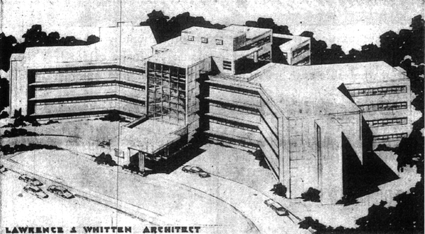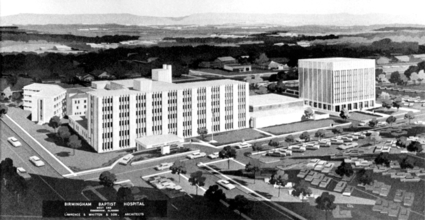Princeton Baptist Medical Center: Difference between revisions
No edit summary |
No edit summary |
||
| Line 5: | Line 5: | ||
The Birmingham Baptist Hospital was founded in [[1922]] as the first campus of what has grown into the [[Baptist Health System]], which also owns [[Citizens Baptist Medical Center]], [[Shelby Baptist Medical Center]], and [[Walker Baptist Medical Center]]. [[Samford Univeristy]]'s [[Ida V. Moffett School of Nursing]] was founded as the nursing school of Baptist Hospital. | The Birmingham Baptist Hospital was founded in [[1922]] as the first campus of what has grown into the [[Baptist Health System]], which also owns [[Citizens Baptist Medical Center]], [[Shelby Baptist Medical Center]], and [[Walker Baptist Medical Center]]. [[Samford Univeristy]]'s [[Ida V. Moffett School of Nursing]] was founded as the nursing school of Baptist Hospital. | ||
The 130-bed hospital was modernized and expanded with a 120-bed "West End Unit", completed in [[1952]], at a cost of $810,000. The adjoining professional building was constructed in the 1960s. Both structures were designed by architect [[Lawrence Whitten]]. | The hospital opened its second location, the [[Highland Avenue Baptist Hospital]], when it purchased the former [[Gorgas Hospital Hotel]] next door to the [[Seale Harris Clinic]] on [[Highland Avenue]] at [[23rd Street South]] in [[1934]]. | ||
The original 130-bed hospital was modernized and expanded with a 120-bed "West End Unit", completed in [[1952]], at a cost of $810,000. The adjoining professional building was constructed in the 1960s. Both structures were designed by architect [[Lawrence Whitten]]. | |||
The hospital added a third professional office building in [[1992]]. Beginning in [[2003]] the hospital invested $73 million in upgraded equipment and renovations to patient rooms. The [[Princeton BMC Healing Garden]] was constructed in [[2005]]. | The hospital added a third professional office building in [[1992]]. Beginning in [[2003]] the hospital invested $73 million in upgraded equipment and renovations to patient rooms. The [[Princeton BMC Healing Garden]] was constructed in [[2005]]. | ||
Revision as of 09:36, 22 January 2016
Princeton Baptist Medical Center (originally Birmingham Baptist Hospital, abbreviated Princeton BMC) is located at 701 Princeton Avenue near the intersection of Tuscaloosa Avenue, Princeton Parkway, and Lomb Avenue in West End. The hospital currently operates about 300 beds of a total of 499 for which it is licensed. Keith Parrott is the hospital's chief executive officer.
The Birmingham Baptist Hospital was founded in 1922 as the first campus of what has grown into the Baptist Health System, which also owns Citizens Baptist Medical Center, Shelby Baptist Medical Center, and Walker Baptist Medical Center. Samford Univeristy's Ida V. Moffett School of Nursing was founded as the nursing school of Baptist Hospital.
The hospital opened its second location, the Highland Avenue Baptist Hospital, when it purchased the former Gorgas Hospital Hotel next door to the Seale Harris Clinic on Highland Avenue at 23rd Street South in 1934.
The original 130-bed hospital was modernized and expanded with a 120-bed "West End Unit", completed in 1952, at a cost of $810,000. The adjoining professional building was constructed in the 1960s. Both structures were designed by architect Lawrence Whitten.
The hospital added a third professional office building in 1992. Beginning in 2003 the hospital invested $73 million in upgraded equipment and renovations to patient rooms. The Princeton BMC Healing Garden was constructed in 2005.
In 2006 Princeton Baptist constructed a $2 million parking garage on its campus. The Simon-Williamson Clinic constructed a $16 million practice building at the hospital in 2007. In 2008 the hospital embarked on a $75 million construction program, adding 90,000 square feet of new space and renovating 60,000 more square feet. New construction will include 14 operating rooms and six endoscopy suites as well as a new entrance and a waiting area for the cardiovascular services wing. Renovations will upgrade the hospitals chapel and recovery suites.
References
- "W. E. Baptist Hospital to have 250 beds after big expansion" (June 1951) Birmingham News - via Birmingham Rewound
- Velasco, Anna (September 14, 2008) "Princeton plans major construction and renovation project in West End." Birmingham News
- Underwood, Jerry (December 1, 2010) "Princeton Baptist says $57 million expansion project under way." Birmingham News
External links
- Baptist Health System web site

